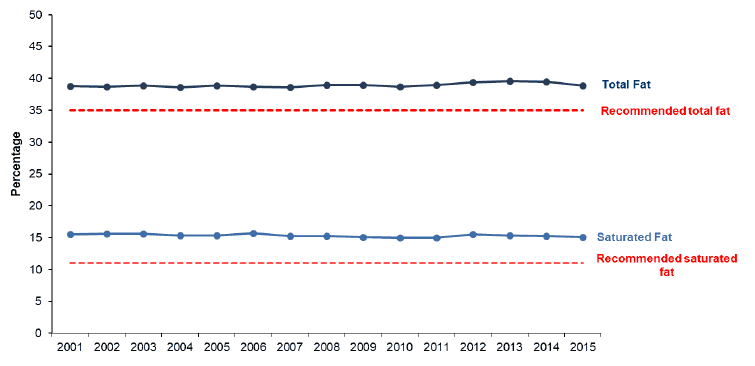Obesity indicators 2018
Latest results against the obesity indicator framework originally developed to monitor progress against our Prevention of Obesity Route Map (2010). The Route Map has now been overtaken by the Diet and Healthy Weight Delivery Plan and Active Scotland Delivery Plan published in summer 2018.
This document is part of a collection
Total and saturated fat
Source: Food Standards Scotland
Latest Results[15]
- In 2015, the percentage of household food energy from all fats was 38.9%. This is above the recommendation of no more than 35% and has remained relatively stable over time.
- The percentage of food energy from saturated fat was 15.1%, compared with the recommendation of no more than 11%.
Figure 6. Proportion of household food energy from fat, 2001-2015

Source:
- Food Standards Scotland commissioned analysis of data from the ONS Living Cost and Food Survey. Estimated nutrient intakes are calculated from household food purchases following secondary analysis to convert purchase data to mean per capita consumption and nutrient intakes and to allow meaningful comparisons to be made between years.
Equalities:
Information is collected on differences in food and nutrient intake by deprivation (using the Scottish Index of Multiple Deprivation (SIMD)).
Geography available: Population level information is collected on differences in food and nutrient intake by urban/rural classification.
Rationale for including total and saturated fat:
These data are useful to monitor change in the proportion of the population consuming energy dense foods. Currently people are eating more saturated fat on average than is recommended (FSAS Barton et al, 2010). Prevalence of obesity indicates that energy intakes currently exceed energy requirements. Both these issues raise serious health concerns, particularly in relation to coronary heart disease, high blood pressure, stroke, Type 2 diabetes and certain types of cancers (SHeS).
Recommendations for food and nutrient intake are based on advice from the Committee on Medical Aspects of Food and Nutrition Policy (COMA) and the Scientific Advisory Committee on Nutrition (SACN). Published Dietary Reference Values cover a range of intakes for most nutrients and for fat and saturated fat are set as a percentage of daily energy intake for adults.
Factors influencing total and saturated fat:
- Availability, cost, and access to different food types.
Contact
Email: Xanthippi Gounari
There is a problem
Thanks for your feedback